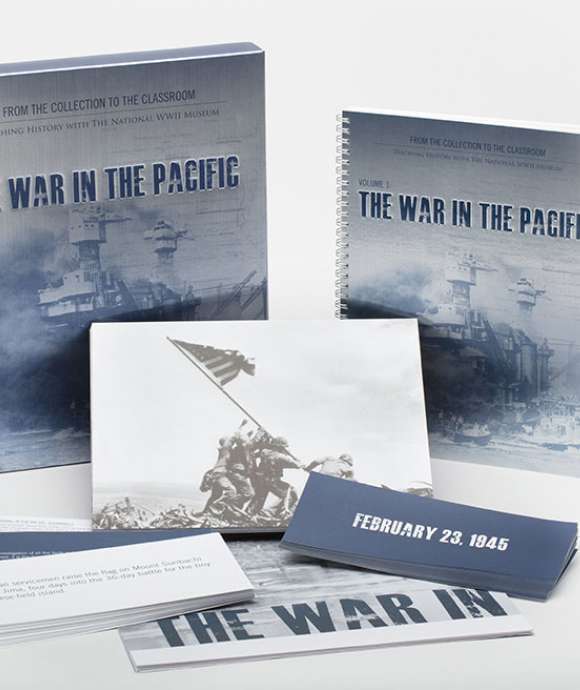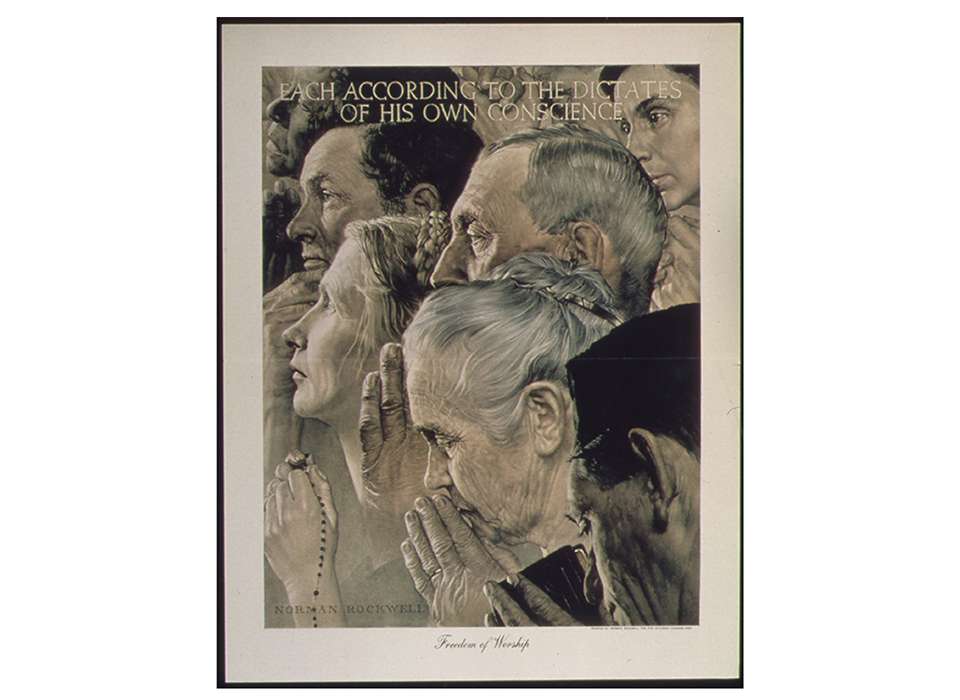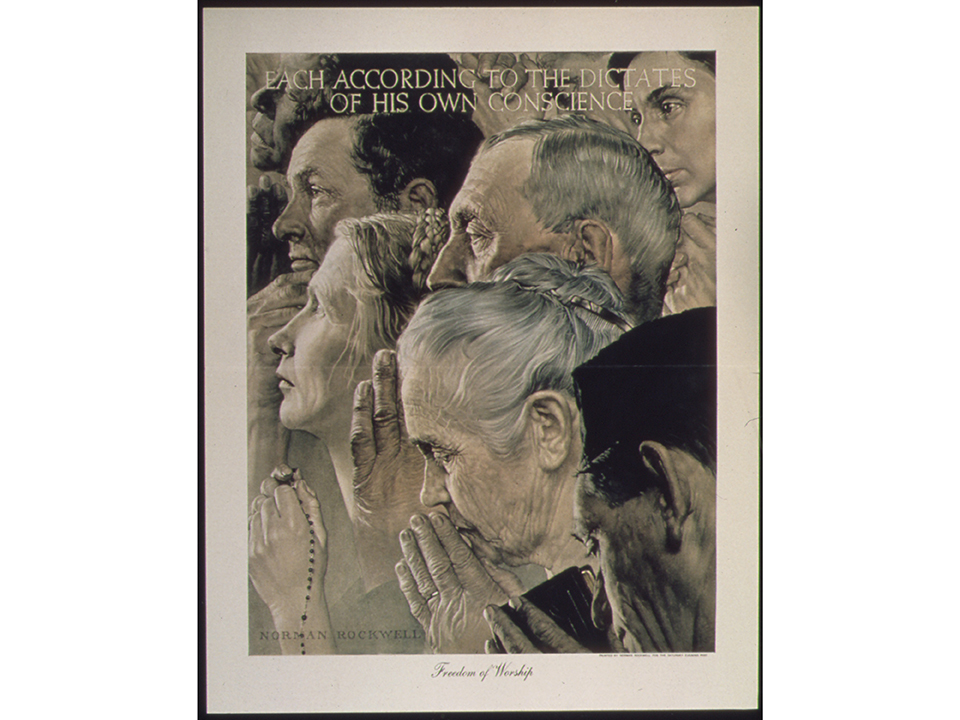Eleven months before the Japanese Empire launched a surprise attack on Pearl Harbor, President Franklin Roosevelt (FDR) gave a speech that came to symbolize the broader meaning behind America’s effort to defeat fascism abroad. Delivered during the State of the Union on January 6, 1941, Roosevelt took a stance against the calls for isolationism prevalent at that time and issued a call to action to defend global democracy, stating that the United States had a responsibility to fight for four universal freedoms people the world over ought to enjoy. After the United States formally entered the war in December 1941, these “Four Freedoms” became a driving message behind the need to stop the Axis powers. As captured by this speech, World War II was not simply a war to defeat dictators, but it was a war to preserve the fundamental freedoms that defined life in a free, democratic society.
The Freedoms
Although delivered well before the United States joined the other Allied Powers to fight in World War II, Roosevelt’s speech remained closely intertwined with the history and legacy of the war. By describing the grave threat facing democratic societies around the world, he gave voice to the fears that permeated daily life in the months before America’s eventual entrance into the war. He did so to emphasize the urgent need to prepare for war, as well as to continue supporting American allies with arms and munitions. Looking ahead to the war’s end, Roosevelt described a world that he saw as “founded upon four essential human freedoms.” The first of the four freedoms was the freedom of speech. The second he listed was the freedom to worship in one’s own way. The third was the freedom from want. Roosevelt explained this freedom as encompassing the economic stability to ensure “to every nation a healthy peacetime” once the turmoil of war came to an end. The fourth freedom was the freedom from fear, which President Roosevelt believed would come with a reduction of armaments worldwide.
Roosevelt saw these freedoms as obtainable in the lifetime of those who, 11 months later, began the march to war. These freedoms—of speech and worship, and from want and fear—gave those who went to war a clear purpose. This speech not only outlined what Americans fought against in World War II, but more importantly, the speech described what was being fought for. Although this speech, delivered in the era of American isolationism, initially received criticism, the ideals Roosevelt put forth cultivated an enduring legacy for the efforts all Americans contributed to the war, both abroad and at home.
In 1942, the artist Norman Rockwell, who had been looking for ways to support the war effort, saw Roosevelt’s Four Freedoms speech as a source of inspiration. Basing each freedom on simple scenes of individuals in town hall meetings, in the midst of prayer, or at home with their families, Rockwell constructed widely successful visual representations of each freedom. The images, originally published in The Saturday Evening Post, proved so popular the US Department of the Treasury sold copies of the paintings to raise money for war bonds. After launching the campaign, roughly 2,000 requests for the posters came in daily. To this day, Rockwell’s illustrations continue to represent glimpses into an idealized American society, inspired by FDR’s aspirations for the postwar world.
Part of artist Norman Rockwell’s series of paintings on the Four Freedoms, depicting followers of different religions engaged in prayer. Image courtesy of the National Archives and Records Administration, 513537.
Legacy
The WWII Victory Medal captured the importance of FDR’s vision by featuring each of the Four Freedoms on the back side of the medal. Created through an act of Congress, the United States military awarded this medal to all who served between the dates of December 7, 1941, and December 31, 1946, the date President Harry Truman declared an official end of hostilities. The WWII Victory Medal, commonly referred to as the “Victory Ribbon,” depicted a figure of Liberation, holding a broken blade in one hand and the hilt of a broken sword in the other. Liberation’s foot rested upon the top of a helmet to indicate victory in war. On the reverse, the Four Freedoms appeared in bold lettering, a reminder of what those who served fought to protect.
While FDR did not live to see the war come to an end, the vision he presented in January 1941 proved an enduring source of guidance in the years that followed Germany’s and Japan’s formal surrender. His widow, Eleanor Roosevelt, incorporated the language of the Four Freedoms within the Preamble of the Universal Declaration of Human Rights, which states,
“Whereas disregard and contempt for human rights have resulted in barbarous acts which have outraged the conscience of mankind, and the advent of a world in which human beings shall enjoy freedom of speech and belief and freedom from fear and want has been proclaimed as the highest aspiration of the common people.”
Preamble of the Universal Declaration of Human Rights
Adopted by the United Nations on December 10, 1948, during an era of increasing decolonization that followed World War II, this Declaration recognized need to protect these fundamental human rights the world over. Following this victory, Eleanor continued to advocate for her late husband’s vision throughout the rest of her life. In a broadcast given in 1951, Eleanor made it clear: “It isn’t enough to talk about peace. One must believe in it. And it isn’t enough to believe in it. One must work at it.” Decades later, the Four Freedoms remains a guiding message in the protection and preservation of human rights. Included in the language of the International Bill of Human Rights, ratified in 1976, and preserved in the iconic Norman Rockwell paintings, FDR’s speech serves as a reminder of the freedoms people can enjoy, should they remain willing to defend them.

Like this article? Read more in our online classroom.
From the Collection to the Classroom: Teaching History with The National WWII Museum.
Kristen D. Burton, PhD
Kristen D. Burton, PhD, is a former Teacher Programs and Curriculum Specialist at The National WWII Museum.
Cite this article:
MLA Citation:
APA Citation:
Chicago Style Citation:










